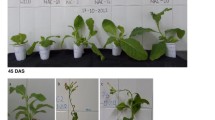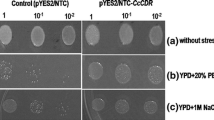Abstract
Ran is a multifunctional small GTPase involved in important cellular activities like nucleocytoplasmic transport, mitotic spindle assembly, nuclear envelope formation, etc., but is also known to be differentially expressed in response to abiotic stress, particularly low temperature. We have over-expressed Lepidium latifolium (Fam. Brassicaceae) Ran gene in tobacco to study the response of the plants to cold stress (24 h; 4 °C). Transformation of the tobacco plants was verified using PCR targeting Ran gene and co-transformed selectable marker gene nptII. Segregation in Mendelian ratios was validated in five transgenic lines by germination of T1 and T2 seeds on moist filter papers containing 150 mg/l kanamycin. Higher levels of electrolyte leakage and lipid peroxidation pointed towards hypersensitivity of plants. Similarly, lesser proline accumulation compared to wild types also indicated susceptibility of plants to death under chilling conditions. Specific activity of antioxidant enzymes superoxide dismutase and glutathione reductase was also measured under stressed and control conditions. A variation was observed across the different lines, and four out of five lines showed lesser specific activity compared to wild type plants, thus indicating reduced capability of scavenging free radicals. In totality, a strong evidence on induced hypersensitivity to cold stress has been collected which may further be helpful in designing appropriate strategies for engineering crop plants for survival under cold stress conditions.






Similar content being viewed by others
References
Zhao Q, Leung S, Corbett AH, Meier I (2006) Identification and characterization of the Arabidopsis orthologs of nuclear transport factor 2, the nuclear import factor of ran. Plant Physiol 140(3):869–878
Ciciarello M, Mangiacasale R, Lavia P (2007) Spatial control of mitosis by the GTPase Ran. Cell Mol Life Sci 64(15):1891–1914
Zang A, Xu X, Neill S, Cai W (2010) Overexpression of OsRAN2 in rice and Arabidopsis renders transgenic plants hypersensitive to salinity and osmotic stress. J Exp Bot 61(3):777–789
Ach RA, Gruissem W (1994) A small nuclear GTP-binding protein from tomato suppresses a Schizosaccharomyces pombe cell-cycle mutant. Proc Natl Acad Sci 91(13):5863–5867
Haizel T, Merkle T, Pay A, Fejes E, Nagy F (1997) Characterization of proteins that interact with the GTP-bound form of the regulatory GTPase Ran in Arabidopsis. Plant J 11(1):93–103
Wang X, Xu Y, Han Y, Bao S, Du J, Yuan M, Xu Z, Chong K (2006) Overexpression of RAN1 in rice and Arabidopsis alters primordial meristem, mitotic progress, and sensitivity to auxin. Plant Physiol 140(1):91–101
Sinha VB (2011) Studies on freezing stress downregulated genes from Lepidium. Kumaun University, Nainital
Lee Y, Kim M-H, Kim S-K, Kim S-H (2008) Phytochrome-mediated differential gene expression of plant Ran/TC4 small G-proteins. Planta 228(1):215–224
Cho H-K, Park J-A, Pai H-S (2008) Physiological function of NbRanBP1 in Nicotiana benthamiana. Mol Cells 26(3):270
Xiong L, Zhu JK (2001) Abiotic stress signal transduction in plants: molecular and genetic perspectives. Physiol Plant 112(2):152–166
Mosammaparast N, Pemberton LF (2004) Karyopherins: from nuclear-transport mediators to nuclear-function regulators. Trends Cell Biol 14(10):547–556
Harel A, Forbes DJ (2004) Importin beta: conducting a much larger cellular symphony. Mol Cell 16(3):319–330
Chinnusamy V, Gong Z, Zhu J-K (2008) Nuclear RNA export and its importance in abiotic stress responses of plants. In: Reddy ASN, Golovkin MV (eds) Nuclear pre-mRNA processing in plants series: current topics in microbiology and immunology, Vol 326, pp 235–255
Aslam M, Sinha VB, Singh RK, Anandhan S, Pande V, Ahmed Z (2010) Isolation of cold stress-responsive genes from Lepidium latifolium by suppressive subtraction hybridization. Acta Physiol Plant 32(1):205–210
Aslam M, Grover A, Sinha VB, Fakher B, Pande V, Yadav PV, Gupta SM, Anandhan S, Ahmed Z (2012) Isolation and characterization of cold responsive NAC gene from Lepidium latifolium. Mol Biol Rep 39(10):9629–9638
Sinha VB, Grover A, Ahmed Z, Pande V (2014) Isolation and functional characterization of DNA damage repair protein from Lepidium latifolium L. C R Biol 337(5):302–310
Sinha VB, Grover A, Aslam M, Pande V, Ahmed Z (2014) Isolation and characterization of Ras related GTP binding protein (Ran) from Lepidium latifolium L. reveals its potential role in regulating abiotic stress tolerance. Acta Physiol Plant
Murashige T, Skoog F (1962) A revised medium for rapid growth and bio assays with tobacco tissue cultures. Physiol Plant 15(3):473–497
Doyle JJ, Doyle JL (1987) A rapid DNA isolation procedure for small quantities of fresh leaf tissue. Phytochem Bull 19(1):11–15
Dionisio-Sese ML, Tobita S (1998) Antioxidant responses of rice seedlings to salinity stress. Plant Sci 135(1):1–9
Wang Y, Qiu L, Dai C, Wang J, Luo J, Zhang F, Ma J (2008) Expression of insect (Microdera puntipennis dzungarica) antifreeze protein MpAFP149 confers the cold tolerance to transgenic tobacco. Plant Cell Rep 27(8):1349–1358
Bates L, Waldren R, Teare I (1973) Rapid determination of free proline for water-stress studies. Plant Soil 39(1):205–207
Bradford MM (1976) A rapid and sensitive method for the quantitation of microgram quantities of protein utilizing the principle of protein-dye binding. Anal Biochem 72(1):248–254
Roy R, Purty RS, Agrawal V, Gupta SC (2006) Transformation of tomato cultivar ‘Pusa Ruby’ with bspA gene from Populus tremula for drought tolerance. Plant Cell Tissue Organ Cult 84(1):56–68
Janero DR (1990) Malondialdehyde and thiobarbituric acid-reactivity as diagnostic indices of lipid peroxidation and peroxidative tissue injury. Free Radical Biol Med 9(6):515–540
Singh S, Rathore M, Goyary D, Singh RK, Anandhan S, Sharma DK, Ahmed Z (2011) Induced ectopic expression of At-CBF1 in marker-free transgenic tomatoes confers enhanced chilling tolerance. Plant Cell Rep 30(6):1019–1028
Hoekstra FA, Golovina EA, Buitink J (2001) Mechanisms of plant desiccation tolerance. Trends Plant Sci 6(9):431–438
Yadeghari LZ, Heidari R, Carapetian J (2008) The influence of cold acclimation on proline, malondialdehyde (MDA), Total protein and pigments contents in soybean (Glycine max) seedlings. Res J Biol Sci 3(1):74–79
Strand Å, Foyer C, Gustafsson P, Gardeström P, Hurry V (2003) Altering flux through the sucrose biosynthesis pathway in transgenic Arabidopsis thaliana modifies photosynthetic acclimation at low temperatures and the development of freezing tolerance. Plant, Cell Environ 26(4):523–535
Hare P, Cress W (1997) Metabolic implications of stress-induced proline accumulation in plants. Plant Growth Regul 21(2):79–102
Khedr AHA, Abbas MA, Wahid AAA, Quick WP, Abogadallah GM (2003) Proline induces the expression of salt-stress-responsive proteins and may improve the adaptation of Pancratium maritimum L. to salt-stress. J Exp Bot 54(392):2553–2562
Baek K-H, Skinner DZ, Ling P, Chen X (2006) Molecular structure and organization of the wheat genomic manganese superoxide dismutase gene. Genome 49(3):209–218
Rahimizadeh M, Habibi D, Madani H, Mohammadi G, Mehraban A, Sabet A (2007) The effect of micronutrients on antioxidant enzymes metabolism in sunflower (Helianthus annuus L.) under drought stress. Helia 30(47):167–173
Khare N, Goyary D, Singh NK, Shah P, Rathore M, Anandhan S, Sharma D, Arif M, Ahmed Z (2010) Transgenic tomato cv. Pusa Uphar expressing a bacterial mannitol-1-phosphate dehydrogenase gene confers abiotic stress tolerance. Plant Cell Tissue Organ Cult 103(2):267–277
Acknowledgments
Vimlendu Bhushan Sinha and Sadhana Singh thank Defence Research and Development Organization (DRDO), India for providing financial assistance.
Author information
Authors and Affiliations
Corresponding author
Additional information
Vimlendu Bhushan Sinha and Atul Grover have contributed equally to this work.
Rights and permissions
About this article
Cite this article
Sinha, V.B., Grover, A., Singh, S. et al. Overexpression of Ran gene from Lepidium latifolium L. (LlaRan) renders transgenic tobacco plants hypersensitive to cold stress. Mol Biol Rep 41, 5989–5996 (2014). https://doi.org/10.1007/s11033-014-3476-z
Received:
Accepted:
Published:
Issue Date:
DOI: https://doi.org/10.1007/s11033-014-3476-z




